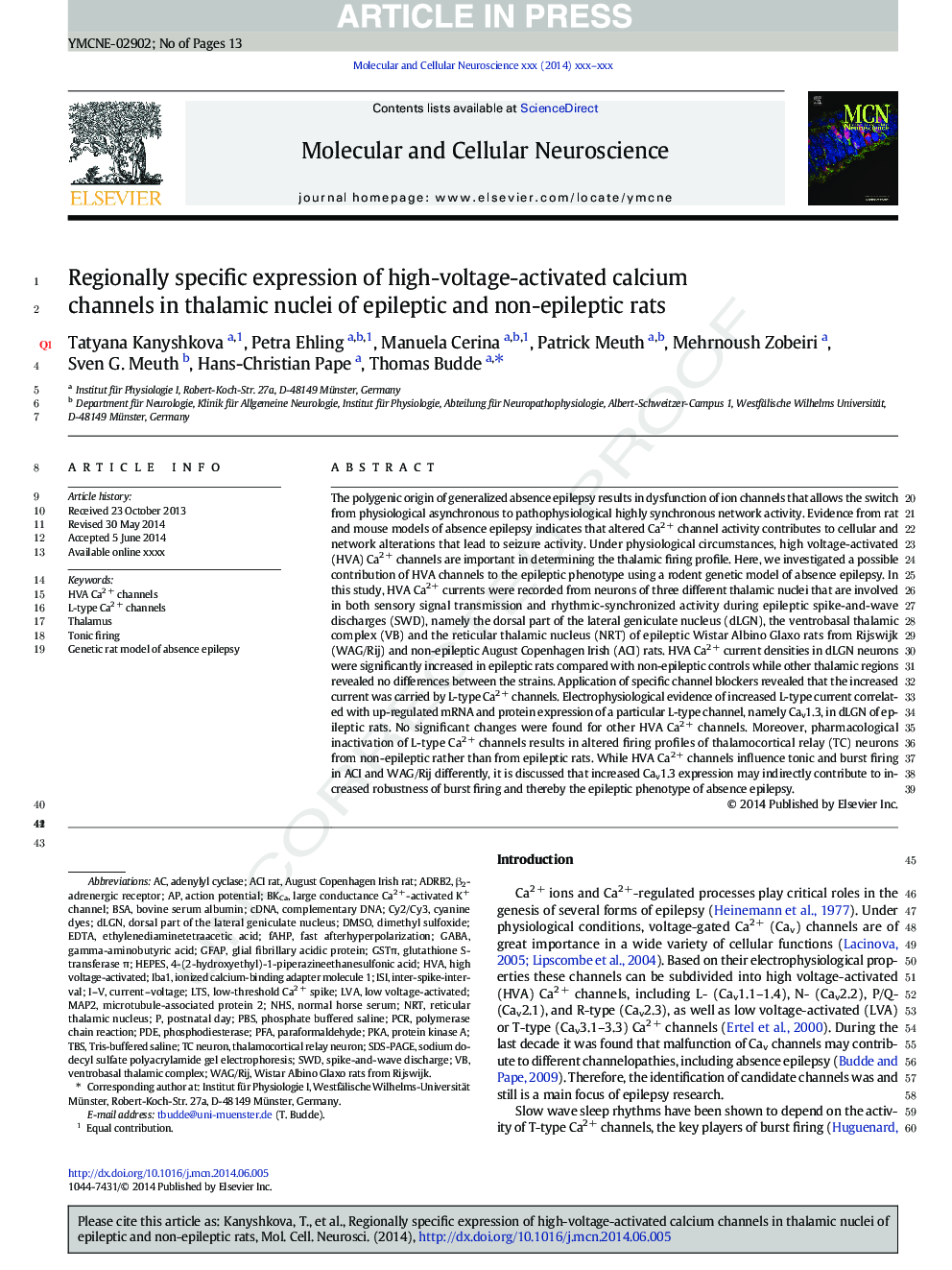| Article ID | Journal | Published Year | Pages | File Type |
|---|---|---|---|---|
| 8478609 | Molecular and Cellular Neuroscience | 2014 | 13 Pages |
Abstract
The polygenic origin of generalized absence epilepsy results in dysfunction of ion channels that allows the switch from physiological asynchronous to pathophysiological highly synchronous network activity. Evidence from rat and mouse models of absence epilepsy indicates that altered Ca2Â + channel activity contributes to cellular and network alterations that lead to seizure activity. Under physiological circumstances, high voltage-activated (HVA) Ca2Â + channels are important in determining the thalamic firing profile. Here, we investigated a possible contribution of HVA channels to the epileptic phenotype using a rodent genetic model of absence epilepsy. In this study, HVA Ca2+ currents were recorded from neurons of three different thalamic nuclei that are involved in both sensory signal transmission and rhythmic-synchronized activity during epileptic spike-and-wave discharges (SWD), namely the dorsal part of the lateral geniculate nucleus (dLGN), the ventrobasal thalamic complex (VB) and the reticular thalamic nucleus (NRT) of epileptic Wistar Albino Glaxo rats from Rijswijk (WAG/Rij) and non-epileptic August Copenhagen Irish (ACI) rats. HVA Ca2Â + current densities in dLGN neurons were significantly increased in epileptic rats compared with non-epileptic controls while other thalamic regions revealed no differences between the strains. Application of specific channel blockers revealed that the increased current was carried by L-type Ca2+ channels. Electrophysiological evidence of increased L-type current correlated with up-regulated mRNA and protein expression of a particular L-type channel, namely Cav1.3, in dLGN of epileptic rats. No significant changes were found for other HVA Ca2+ channels. Moreover, pharmacological inactivation of L-type Ca2Â + channels results in altered firing profiles of thalamocortical relay (TC) neurons from non-epileptic rather than from epileptic rats. While HVA Ca2Â + channels influence tonic and burst firing in ACI and WAG/Rij differently, it is discussed that increased Cav1.3 expression may indirectly contribute to increased robustness of burst firing and thereby the epileptic phenotype of absence epilepsy.
Keywords
MAP2LVAPDENRTpKaPFAdLGNLTSNHSPBSIBA1SWDADRB2FAHPACI ratventrobasal thalamic complexGSTπglutathione S-transferase πHEPESGFAPTBS4-(2-hydroxyethyl)-1-piperazineethanesulfonic acidBKCaBSAcDNADMSOComplementary DNAI–VWAG/Rijadenylyl cyclasebovine serum albuminISIEDTAEthylenediaminetetraacetic acidgamma-aminobutyric acidSDS-PAGESodium dodecyl sulfate polyacrylamide gel electrophoresisThalamusSpike-and-wave dischargeTris-buffered salinecurrent–voltageDimethyl sulfoxideCyanine dyespostnatal daynormal horse serumPhosphate buffered salinePhosphodiesteraseionized calcium-binding adapter molecule 1reticular thalamic nucleuspolymerase chain reactionPCRhigh voltage-activatedlow voltage-activatedparaformaldehydeaction potentialGlial fibrillary acidic proteinmicrotubule-associated protein 2protein kinase Afast afterhyperpolarizationHVAGABAβ2-adrenergic receptor
Related Topics
Life Sciences
Biochemistry, Genetics and Molecular Biology
Cell Biology
Authors
Tatyana Kanyshkova, Petra Ehling, Manuela Cerina, Patrick Meuth, Mehrnoush Zobeiri, Sven G. Meuth, Hans-Christian Pape, Thomas Budde,
